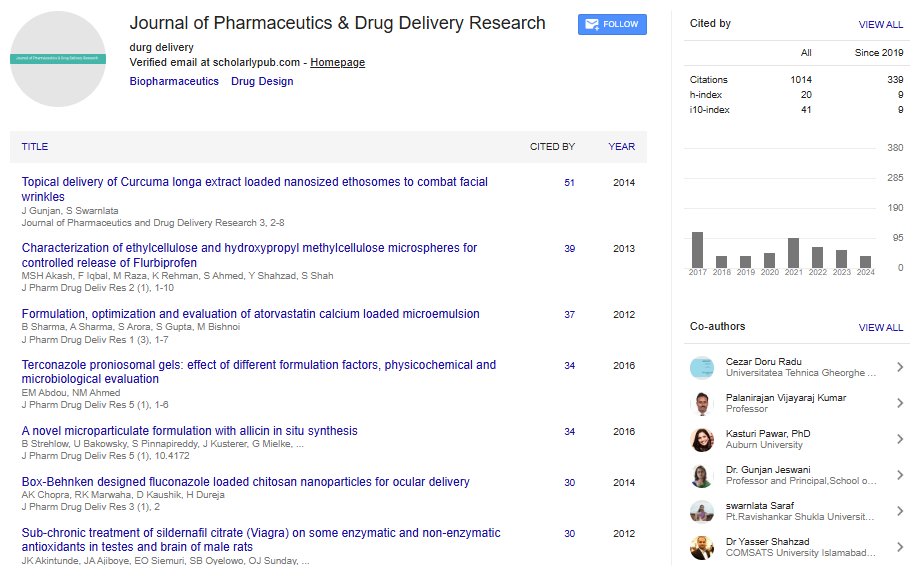Perspective, J Pharm Drug Deliv Res Vol: 13 Issue: 5
A Comprehensive Guide of Safe Medication Practices: Contraindications
Jie Zhang*
1Department of Pharmaceutical Sciences, Punjabi University, Patiala, India
*Corresponding Author: Jie Zhang,
Department of Pharmaceutical Sciences,
Punjabi University, Patiala, India
E-mail: zhangj39@gmail.com
Received date: 26 August, 2024, Manuscript No. JPDDR-24-151930;
Editor assigned date: 28 August, 2024, PreQC No. JPDDR-24-151930 (PQ);
Reviewed date: 11 September, 2024, QC No. JPDDR-24-151930;
Revised date: 18 September, 2024, Manuscript No. JPDDR-24-151930 (R);
Published date: 26 September, 2024, DOI: 10.4172/2325-9604.1000297
Citation: Jie Zhang (2024) A Comprehensive Guide of Safe Medication Practices: Contraindications. J Pharm Drug Deliv Res 13:5.
Description
In the world of medicine, ensuring patient safety is paramount. One crucial aspect of this is recognizing and understanding contraindications conditions or factors that make certain medical treatments, particularly medications, inadvisable or even dangerous. Knowing about contraindications allows healthcare providers to make safer choices for patients, reducing the risk of adverse reactions and ensuring more effective treatment plans. This article discovers the concept of contraindications, their types, examples and their significance in medical practice.
Contraindications are specific situations or conditions in which a particular drug, procedure, or treatment should not be used because it may harm the patient. For example, a person who has a known allergy to penicillin should not be given any medication from the penicillin family, as it could trigger a severe allergic reaction. Contraindications are assessed and monitored by healthcare providers to tailor treatment plans to each individual’s unique medical history, current conditions and potential risks.
In these cases, a particular medication or treatment should never be used due to the high risk of severe adverse effects. For instance, the blood-thinning medication warfarin is absolutely contraindicated in patients with a history of severe bleeding disorders, as it could lead to life-threatening hemorrhages.
This type of contraindication means that a particular treatment is generally inadvisable but might be used if the benefits outweigh the risks in specific situations. For instance, a Nonsteroidal Anti- Inflammatory Drug (NSAID) might be relatively contraindicated for a patient with a history of gastric ulcers, but if pain relief is precarious, the doctor may carefully monitor the patient and use the drug at the lowest effective dose.
Many medications can cause allergic reactions in some patients. For example, antibiotics such as penicillin or sulfa drugs are contraindicated for patients who have a known allergy to these substances. Allergic reactions can range from mild skin rashes to severe anaphylaxis, making it essential to identify and avoid allergens.
During pregnancy, certain drugs can harm the developing fetus. Medications such as isotretinoin (used for acne) and warfarin are contraindicated in pregnancy because they can lead to birth defects or developmental issues. Pregnant patients are often prescribed alternative treatments that pose less risk to both mother and child.
Patients with chronic conditions like heart disease, diabetes, or kidney disease often require special consideration when medications are prescribed. For example, non-selective beta-blockers may be contraindicated in asthma patients as they can cause bronchospasm, worsening respiratory symptoms. In such cases, healthcare providers may choose medications that are less likely to trigger adverse reactions based on the patient's pre-existing conditions.
Some medications may be contraindicated due to their interactions with other drugs a patient is already taking. For example, combining certain antidepressants with monoamine oxidase inhibitors (MAOIs) can cause a dangerous spike in blood pressure, known as hypertensive crisis. It is precarious for healthcare providers to review all medications a patient is taking to avoid harmful interactions.
Importance of recognizing contraindications
Understanding and identifying contraindications play a serious role in preventing adverse drug reactions and safeguarding patient health. For healthcare providers, assessing contraindications helps in developing safer, personalized treatment plans. Patients also play a role by communicating their health histories and allergies accurately, ensuring their providers have all the information necessary for safe treatment decisions.
Properly recognizing contraindications allows for more accurate prescribing and fewer adverse reactions. When contraindications are overlooked, patients can suffer from side effects, complications, or worsened health conditions. By being vigilant, healthcare providers significantly reduce the likelihood of these events.
Contraindications also affect how well a treatment works. Administering a contraindicated drug might not only endanger the patient but also compromise the treatment's effectiveness, which can delay recovery. Alternative treatments that align with a patient’s medical background can help achieve better therapeutic outcomes.
It is important to educate patients on the importance of reporting any known allergies, ongoing medications and health conditions. Patients who understand the significance of contraindications are more likely to follow medical advice carefully and avoid risky selfmedication practices.
 Spanish
Spanish  Chinese
Chinese  Russian
Russian  German
German  French
French  Japanese
Japanese  Portuguese
Portuguese  Hindi
Hindi 
